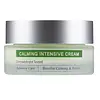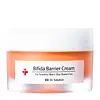What's inside
What's inside
 Key Ingredients
Key Ingredients

 Benefits
Benefits

 Concerns
Concerns

 Ingredients Side-by-side
Ingredients Side-by-side

Water
Skin ConditioningButylene Glycol
HumectantGlycerin
HumectantMethylpropanediol
SolventTriethyl Citrate
MaskingNeopentyl Glycol Dicaprylate/Dicaprate
Emollient1,2-Hexanediol
Skin ConditioningMacadamia Ternifolia Seed Oil
EmollientBetaine
HumectantC15-19 Alkane
SolventAmmonium Acryloyldimethyltaurate/Vp Copolymer
Caprylic/Capric Triglyceride
MaskingButyrospermum Parkii Butter
Skin ConditioningDicaprylyl Carbonate
EmollientTroxerutin
Skin ConditioningAcrylates/C10-30 Alkyl Acrylate Crosspolymer
Emulsion StabilisingTromethamine
BufferingXanthan Gum
EmulsifyingAllantoin
Skin ConditioningPanthenol
Skin ConditioningGlyceryl Stearate
EmollientStearyl Alcohol
EmollientPolyglyceryl-3 Methylglucose Distearate
EmulsifyingSodium Hyaluronate
HumectantDipotassium Glycyrrhizate
HumectantEthylhexylglycerin
Skin ConditioningMelia Azadirachta Leaf Extract
Skin ConditioningCentella Asiatica Extract
CleansingMelia Azadirachta Flower Extract
Skin ConditioningHydrogenated Lecithin
EmulsifyingPolyglyceryl-10 Diisostearate
EmulsifyingMenadione
MaskingPortulaca Oleracea Extract
Skin ConditioningWater, Butylene Glycol, Glycerin, Methylpropanediol, Triethyl Citrate, Neopentyl Glycol Dicaprylate/Dicaprate, 1,2-Hexanediol, Macadamia Ternifolia Seed Oil, Betaine, C15-19 Alkane, Ammonium Acryloyldimethyltaurate/Vp Copolymer, Caprylic/Capric Triglyceride, Butyrospermum Parkii Butter, Dicaprylyl Carbonate, Troxerutin, Acrylates/C10-30 Alkyl Acrylate Crosspolymer, Tromethamine, Xanthan Gum, Allantoin, Panthenol, Glyceryl Stearate, Stearyl Alcohol, Polyglyceryl-3 Methylglucose Distearate, Sodium Hyaluronate, Dipotassium Glycyrrhizate, Ethylhexylglycerin, Melia Azadirachta Leaf Extract, Centella Asiatica Extract, Melia Azadirachta Flower Extract, Hydrogenated Lecithin, Polyglyceryl-10 Diisostearate, Menadione, Portulaca Oleracea Extract
Bifida Ferment Extract 65%
HumectantGlycerin
HumectantNiacinamide
SmoothingDipropylene Glycol
Humectant1,2-Hexanediol
Skin ConditioningPolyglyceryl-3 Methylglucose Distearate
EmulsifyingCaprylic/Capric Triglyceride
MaskingSorbitan Olivate
EmulsifyingVinyldimethicone
Cyclohexasiloxane
EmollientStearyl Olivate
EmollientButylene Glycol Dicaprylate/Dicaprate
EmollientPropanediol
SolventMacadamia Ternifolia Seed Oil
EmollientSodium Acrylates Copolymer
Glyceryl Glucoside
HumectantButyrospermum Parkii Butter
Skin ConditioningC14-22 Alcohols
Emulsion StabilisingWater
Skin ConditioningLecithin
EmollientC12-20 Alkyl Glucoside
EmulsifyingSqualane
EmollientDimethicone/Vinyl Dimethicone Crosspolymer
Skin ConditioningButylene Glycol
HumectantHouttuynia Cordata Extract
Skin ConditioningSodium Acrylate/Sodium Acryloyldimethyl Taurate Copolymer
Emulsion StabilisingPolyisobutene
Ethylhexylglycerin
Skin ConditioningAdenosine
Skin ConditioningCaprylyl/Capryl Glucoside
CleansingSorbitan Oleate
EmulsifyingLactococcus Ferment Lysate
Skin ConditioningLactobacillus Ferment Lysate
Skin ConditioningLactobacillus/Soybean Ferment Extract
Skin ConditioningLactobacillus
Skin ConditioningYeast
Skin ConditioningLactobacillus/Pear Juice Ferment Filtrate
Skin ConditioningHydrogenated Lecithin
EmulsifyingGlucose
HumectantSoy Isoflavones
Skin ConditioningCeramide NP
Skin ConditioningCopper Tripeptide-1
Skin ConditioningAlanine
MaskingAcetyl Hexapeptide-8
HumectantBifida Ferment Extract 65%, Glycerin, Niacinamide, Dipropylene Glycol, 1,2-Hexanediol, Polyglyceryl-3 Methylglucose Distearate, Caprylic/Capric Triglyceride, Sorbitan Olivate, Vinyldimethicone, Cyclohexasiloxane, Stearyl Olivate, Butylene Glycol Dicaprylate/Dicaprate, Propanediol, Macadamia Ternifolia Seed Oil, Sodium Acrylates Copolymer, Glyceryl Glucoside, Butyrospermum Parkii Butter, C14-22 Alcohols, Water, Lecithin, C12-20 Alkyl Glucoside, Squalane, Dimethicone/Vinyl Dimethicone Crosspolymer, Butylene Glycol, Houttuynia Cordata Extract, Sodium Acrylate/Sodium Acryloyldimethyl Taurate Copolymer, Polyisobutene, Ethylhexylglycerin, Adenosine, Caprylyl/Capryl Glucoside, Sorbitan Oleate, Lactococcus Ferment Lysate, Lactobacillus Ferment Lysate, Lactobacillus/Soybean Ferment Extract, Lactobacillus, Yeast, Lactobacillus/Pear Juice Ferment Filtrate, Hydrogenated Lecithin, Glucose, Soy Isoflavones, Ceramide NP, Copper Tripeptide-1, Alanine, Acetyl Hexapeptide-8
Ingredients Explained
These ingredients are found in both products.
Ingredients higher up in an ingredient list are typically present in a larger amount.
1,2-Hexanediol is a synthetic liquid and another multi-functional powerhouse.
It is a:
- Humectant, drawing moisture into the skin
- Emollient, helping to soften skin
- Solvent, dispersing and stabilizing formulas
- Preservative booster, enhancing the antimicrobial activity of other preservatives
Butylene Glycol (or BG) is used within cosmetic products for a few different reasons:
Overall, Butylene Glycol is a safe and well-rounded ingredient that works well with other ingredients.
Though this ingredient works well with most skin types, some people with sensitive skin may experience a reaction such as allergic rashes, closed comedones, or itchiness.
Learn more about Butylene GlycolThis ingredient is also known as shea butter. It is an effective skin hydrator and emollient.
Emollients help soothe and soften your skin. It does this by creating a protective film on your skin. This barrier helps trap moisture and keeps your skin hydrated. Emollients may be effective at treating dry or itchy skin.
Shea butter is rich in antioxidants. Antioxidants help fight free-radicals, or molecules that may harm the body. It is also full of fatty acids including stearic acid and linoleic acid. These acids help replenish the skin and keep skin moisturized.
While Shea Butter has an SPF rating of about 3-4, it is not a sunscreen replacement.
Shea butter may not be fungal acne safe. We recommend speaking with a professional if you have any concerns.
Learn more about Butyrospermum Parkii ButterThis ingredient is an emollient, solvent, and texture enhancer. It is considered a skin-softener by helping the skin prevent moisture loss.
It helps thicken a product's formula and makes it easier to spread by dissolving clumping compounds.
Caprylic Triglyceride is made by combining glycerin with coconut oil, forming a clear liquid.
While there is an assumption Caprylic Triglyceride can clog pores due to it being derived from coconut oil, there is no research supporting this.
Learn more about Caprylic/Capric TriglycerideEthylhexylglycerin (we can't pronounce this either) is commonly used as a preservative and skin softener. It is derived from glyceryl.
You might see Ethylhexylglycerin often paired with other preservatives such as phenoxyethanol. Ethylhexylglycerin has been found to increase the effectiveness of these other preservatives.
Glycerin is already naturally found in your skin. It helps moisturize and protect your skin.
A study from 2016 found glycerin to be more effective as a humectant than AHAs and hyaluronic acid.
As a humectant, it helps the skin stay hydrated by pulling moisture to your skin. The low molecular weight of glycerin allows it to pull moisture into the deeper layers of your skin.
Hydrated skin improves your skin barrier; Your skin barrier helps protect against irritants and bacteria.
Glycerin has also been found to have antimicrobial and antiviral properties. Due to these properties, glycerin is often used in wound and burn treatments.
In cosmetics, glycerin is usually derived from plants such as soybean or palm. However, it can also be sourced from animals, such as tallow or animal fat.
This ingredient is organic, colorless, odorless, and non-toxic.
Glycerin is the name for this ingredient in American English. British English uses Glycerol/Glycerine.
Learn more about GlycerinHydrogenated Lecithin is created from the hydrogenation of lecithin (a group of phospholipids). Hydrogenation is a chemical reaction between hydrogen and another element.
This ingredient is an emollient and emulsifier. As an emollient, it helps soften skin by trapping moisture within. As an emulsifier, it prevents oil and water ingredients from separating.
Macadamia Ternifolia Seed Oil is the fixed oil obtained from Macadamia nut.
Macadamia seed oil is rich in fatty acids, including oleic acid (45-75%), palmitoleic acid (7-33%), and palmitic acid (6-12%). They also contain various B vitamins, iron, and magnesium.
Palmitoleic acid has been shown to help soothe inflammation and promote wound healing. It is also naturally found in the fat of our skin.
Macadamia seed oil may not be malassezia folliculitis, or fungal-acne, safe.
Learn more about Macadamia Ternifolia Seed OilPolyglyceryl-3 Methylglucose Distearate is created from the diester of stearic acid and the condensation product of methylglucose and Polyglycerin-3.
As an emulsifier, it is used to bind ingredients together. Many ingredients, such as oils and water, separate naturally. Emulsifiers prevent them from separating to ensure even consistency in texture.
One of the manufacturer for this ingredient states it is vegetable-based. It is also claimed to be stable at both high and low temperatures.
This ingredient may not be safe for fungal acne. We recommend speaking with a professional if you have any concerns.
Learn more about Polyglyceryl-3 Methylglucose DistearateWater. It's the most common cosmetic ingredient of all. You'll usually see it at the top of ingredient lists, meaning that it makes up the largest part of the product.
So why is it so popular? Water most often acts as a solvent - this means that it helps dissolve other ingredients into the formulation.
You'll also recognize water as that liquid we all need to stay alive. If you see this, drink a glass of water. Stay hydrated!
Learn more about Water